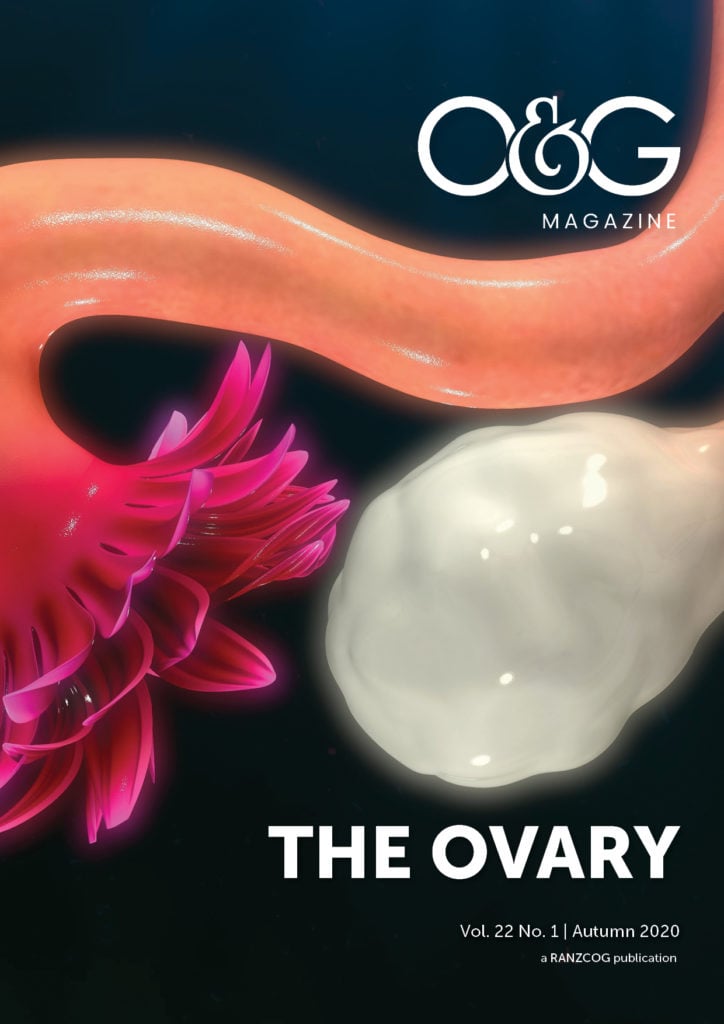Writing and researching
The ANZJOG Author Guidelines are freely available online. Please read these Guidelines, preferably before you start your research and certainly before writing up that research, if you are considering submitting to ANZJOG. We are looking for novel research findings, not necessarily complex or requiring massive laboratory or funding backup.
Please note that we do not publish case reports, and that most Reviews (systematic or short) are invited by the Editor – if you have a brilliant idea please send an email to the Editor before embarking on your review (if you plan to send it to us). We also publish Opinions and Letters – these are peer-reviewed and appear on PubMed and other databases.
Make sure you have appropriate ethical approval for your research, as per the Author Guidelines. Even if your research is likely to be low-risk or is an audit, a statement from an ethics committee confirming that formal approval can be waived is necessary. Consider, too, any conflicts of interest among your researchers.
Think carefully whether your topic is suitable for ANZJOG, which is a clinical journal (no rats, no complex biochemistry). We have an enormous backlog of obstetric original articles, so accepted articles on gynaecology, reproductive endocrinology and infertility, and sexual and reproductive health topics are likely to be published sooner (note this does not mean they are more likely to be accepted for publication – all submissions follow the same peer-review process). Likewise, Short Communications and Letters to the Editor are more likely to be published sooner.
A maximum of 2500 words and 25–30 references does not mean that these need to be achieved – less can be better. Consider whether you need tables and figures – are these clear? Think about your readers – clinical obstetricians and gynaecologists, GP obstetricians and trainees. Write in clear concise English, with UK spelling, correct grammar and full sentences. Consult our guidelines for abbreviations and references; we use the Vancouver system.
The Editorial Board consists of myself and 15 Associate Editors (AEs). I review all submissions, and make an immediate decision: reject, send for review by an AE, or doubtful (the latter is usually discussed with an AE). I also act as an AE.
If the manuscript is sent to an AE, it may be immediately rejected, but most are sent for review, blinded, to at least two reviewers. It can be very difficult and time-consuming to find reviewers – they are experts in their field, often very busy, and often asked to review.
Sometimes reviews are conflicting, or the AE disagrees, or the reviewer doesn’t complete the review. While we aim to get a decision back to authors within six weeks, this is not always possible; sometimes up to 20 possible reviewers have to be approached before two suitable people are found and agree to timely review. If we are experiencing particular difficulty with finding reviewers, we will write to authors to tell them this.
You are able to indicate reviewers you are opposed to and we will observe these requests. You can also recommend reviewers, but these will not always be used by AEs who may consider them unsuitable. Reviewers are always blinded to authors and vice versa.
We are very grateful to those reviewers who review consistently for us and on time. They do this voluntarily, so all published authors should be prepared to review. And clinicians are as important as academics for this: remember that the majority of our readers are clinicians.
Good luck!
– Caroline de Costa
Reviewing
As AEs and reviewers, our roles are to facilitate and provide peer review, constructive feedback and publication recommendations for submissions. This is to ensure manuscripts are relevant and at the required standard for publication, while assisting authors to reach these standards where possible. When reviewing a manuscript, there are six key questions we need to answer:
- Does this manuscript address a clearly focused issue or stated hypothesis, with the results relevant to the focus/hypothesis?
- Do you have statistical concerns about this manuscript?
- Do you have ethical concerns about this manuscript?
- Is the referencing up-to-date and appropriate?
- Are the conclusions drawn warranted from the data and its interpretation?
- Is the language acceptable?
As mentioned, all AEs and reviewers are busy clinicians and/or academics. To assist them to answer these questions and increase the likelihood of your manuscript being accepted, there are a number of helpful strategies. Many of these strategies start at the early stages of planning the study and resulting manuscript prior to conducting the study:
- When you have an idea for a study, perform a rapid review of the literature, using keywords and literature search engines, such as Google Scholar or Pubmed, to help clarify your hypothesis, the question your study will attempt to answer and the need to answer this question. For most studies, the PI(C)O approach: Population, Intervention (+/- Comparator), Outcome, will help define your question. Keep a record of search terms and relevant papers to assist with referencing as you go.
- State your hypothesis and define a primary objective for your study.
- Consider and choose the most suitable study methodology, both from a scientific rigour and feasibility perspective, to assess your question, hypothesis and achieve your objective.
- At an early stage, seek advice from a statistician to develop a statistical analysis plan and, when appropriate, from a qualitative researcher to inform your methods and analysis. Such advice is enormously helpful in clarifying your question and ensuring the study design is able to answer that question.
- Discuss your study with your local ethics office to confirm whether an approval is required or waiver sufficient, prior to collecting data. If submitting for ethics review, waiver or quality audit approval, make full use of the quality audit or ethics submission processes, templates and checklists. Every institution will have a different form, but examples of templates are:
- Study protocol template: www.westernhealth.org.au/EducationandResearch/Research/Documents/LNR%20Protocol%20Template.doc
- Quality Assurance Project checklist: www.westernhealth.org.au/EducationandResearch/Research/Documents/WH%20QA%20Checklist%20and%20Site%20Specific%20Form.docx
- While the process may appear onerous, it will assist in designing the study, writing the protocol and ensuring your study has met the ethics approval standard required for publication.
- Start writing the manuscript at the beginning of the study design. As you progress through the question formulation (introduction and hypothesis), design (aims, methods and results format), approval (ethics statement), data collection and analysis (results) phases, you will be left with only the discussion and conclusions.
- The EQUATOR (Enhancing the QUAlity and Transparency Of health Research) network (www.equator-network.org) has reporting guidelines for the publication of most study types. These guidelines will inform the required elements of your study design and what to include in your manuscript.
- When writing the discussion, a suggested format is:
- Summary of key findings in relation to the objectives
- Discussion of interpretation and the implications of findings
- Statement of the strengths and limitations of the findings and study design
- Recommendations for future work
- In the conclusion, avoid overstating the significance and implications of your study results, keeping them consistent with the methods and limitations of the design.
- Be sure to reference any relevant papers as you go, to support statements made, acknowledge sources and minimise the risk of plagiarism.
- Asking a third party with a fresh pair of eyes to proofread your manuscript may help identify any issues prior to submission, including flow, terminology, grammar and punctuation. If English is not your first language, it will also help to have that third party be a native English speaker who works in the clinical field.
Hopefully with careful planning, good advice and support, we can look forward to accepting your next manuscript.
– Oliver Daly
Communicating your research
While citations are an important metric of your research’s impact, there are many other ways in which you can make sure your research gets read and informs practice. Altmetrics.com, for example, measures citations on Wikipedia and in public policy documents, discussions on research blogs, mainstream media coverage, and mentions on social networks, such as Twitter, to determine a journal article’s impact.
Here are some alternative ways in which you can promote your research to a broader audience:
- Do a conference presentation: conferences like RANZCOG’s Annual Scientific Meeting are a great space to share your findings with your peers and make sure that your research informs practice. They are also a great space to hold discussions and get feedback from others in your field and provide fantastic networking opportunities.
- Submit a press release: RANZCOG has an affiliation with the Australia Science Media Centre, an online news portal for journalists with more than 1500 reporters subscribed. Journalists often visit this site to find stories, so if your research is featured here, your chances that it will get picked up by the media increase. RANZCOG is more than happy to help you write and publish press releases in Scimex. If your academic article has recently been accepted for publication in ANZJOG, contact the communications team: [email protected].
- Write a media article: You don’t have to wait until a news outlet decides to pick up and publish your research. Outlets like The Conversation accept submissions from academics, which gives you the freedom to write your article with your own voice and ensure precision and accuracy. News outlets often republish The Conversation articles, which means your research’s reach will be significant.
- Provide media commentary: If writing for the media is not your thing, you can still provide media commentary. Journalists are always looking to fact-check their stories and, as an expert in your research field, who better to do this than you? List your contact details in the Australia Science Media Centre to make yourself available. Feeling unsure about how to talk to media? Come to the next RANZCOG’s media training session at the ASM.
- Share your research on social media: Social media is a great way to start conversations and share your findings with the broader community. Tag and follow ANZJOG and RANZCOG on Twitter. We will retweet your research when possible to make sure it reaches a wider audience.
Research informs practice and moves our specialty forward, but the only way it can do this is if it is communicated with others. While publishing in an academic journal is a great step that provides you with credibility and prestige, publishing in media and social media will make sure your work reaches a broader audience that includes not only academics, but fellow clinicians and women and their families, informing practice and health education on a wider scale.
– Lourdes Zamanillo
Open Research
Research publishing is undergoing a transformation and among the biggest drivers of this are Open Research practices. These practices are having a significant impact on the way that researchers conduct research, write papers and publish their results, and are often grouped into the following ‘pillars’ of open research practices:
Open Access
Driven by the need for research to be widely available to drive adoption, innovation and invention, we are currently seeing a significant push towards Open Access publishing and away from more traditional journal subscription models. There are two main ways research can be made available under Open Access terms, which encompass both an access element, as well as a copyright element:
Green: Published under a regular copyright agreement in a subscription journal and made freely available on an institutional/subject repository after an embargo period.
Gold: Published under a Creative Commons license and made freely available immediately upon publication in either a fully Open Access journal or within an otherwise subscription-based journal.
Open data
Research data is as important as the published article. When data is FAIR (findable, accessible, interoperable and reusable), the research process becomes more efficient and robust. Data can be used to analyse and reproduce findings, or can be reused and built upon to inform new studies.
Open practices
Open practices encourage transparency throughout the publishing process and include initiatives such as open peer review and the increased use of preprint servers. Sharing how and why we make decisions holds us accountable for our actions and builds trust within our communities, producing results that others can build on. Examples include:
Registered reports: Enabling peer review prior to data collection, emphasising the importance of the research question and the methods. High-quality studies are provisionally accepted, eliminating questionable research practices and publication bias. Preprint servers: Researchers use preprints to accelerate science. Researchers can ‘preprint’ their work on a preprint server before they submit it to a journal for peer review.
Transparent peer review: The identity of the author and the reviewers are known by all participants. A growing minority of journals do this.
Open collaboration
Online tools to help researchers collaborate with co-authors during the writing process, online annotation and personal article libraries, article sharing guidelines and support. These tools will be essential as collaboration continues to increase. When collaboration is easy, researchers can focus on the impact of their research, instead of the process, strengthening their networks and creating the best possible outcome for their findings.
Open recognition and reward
Researchers and academics are constantly under pressure to demonstrate and celebrate the impact of research, and tools are emerging to manage, report on and increase this impact. Academics can get credit for peer review work through Publons, use Kudos and Altmetric to help measure impact and validate identities with ORCiD, while Open Research Badges help gain recognition for taking advantage of the open practices outlined here, such as data sharing and Registered Reports.
– Simon Goudie








Leave a Reply